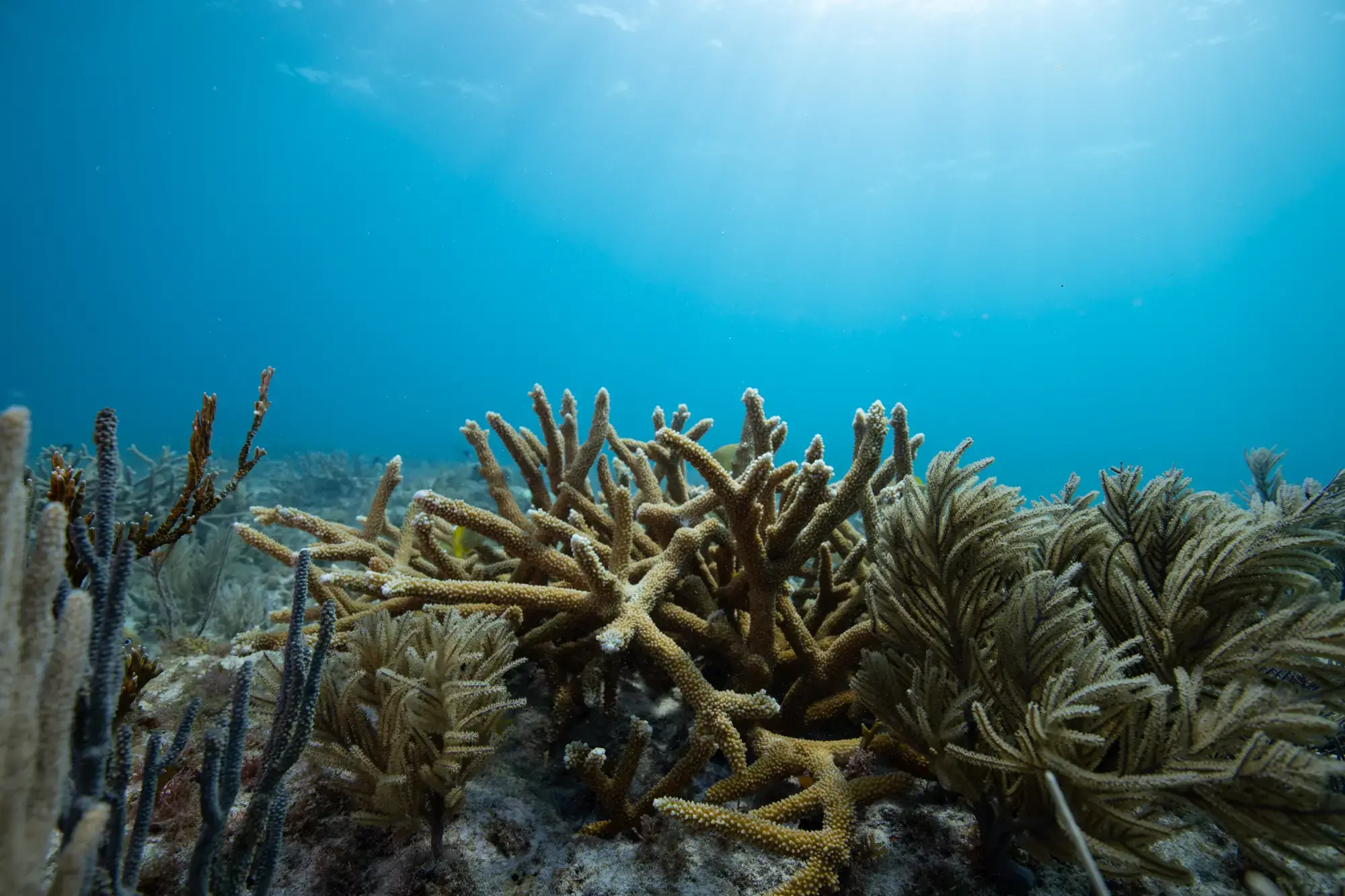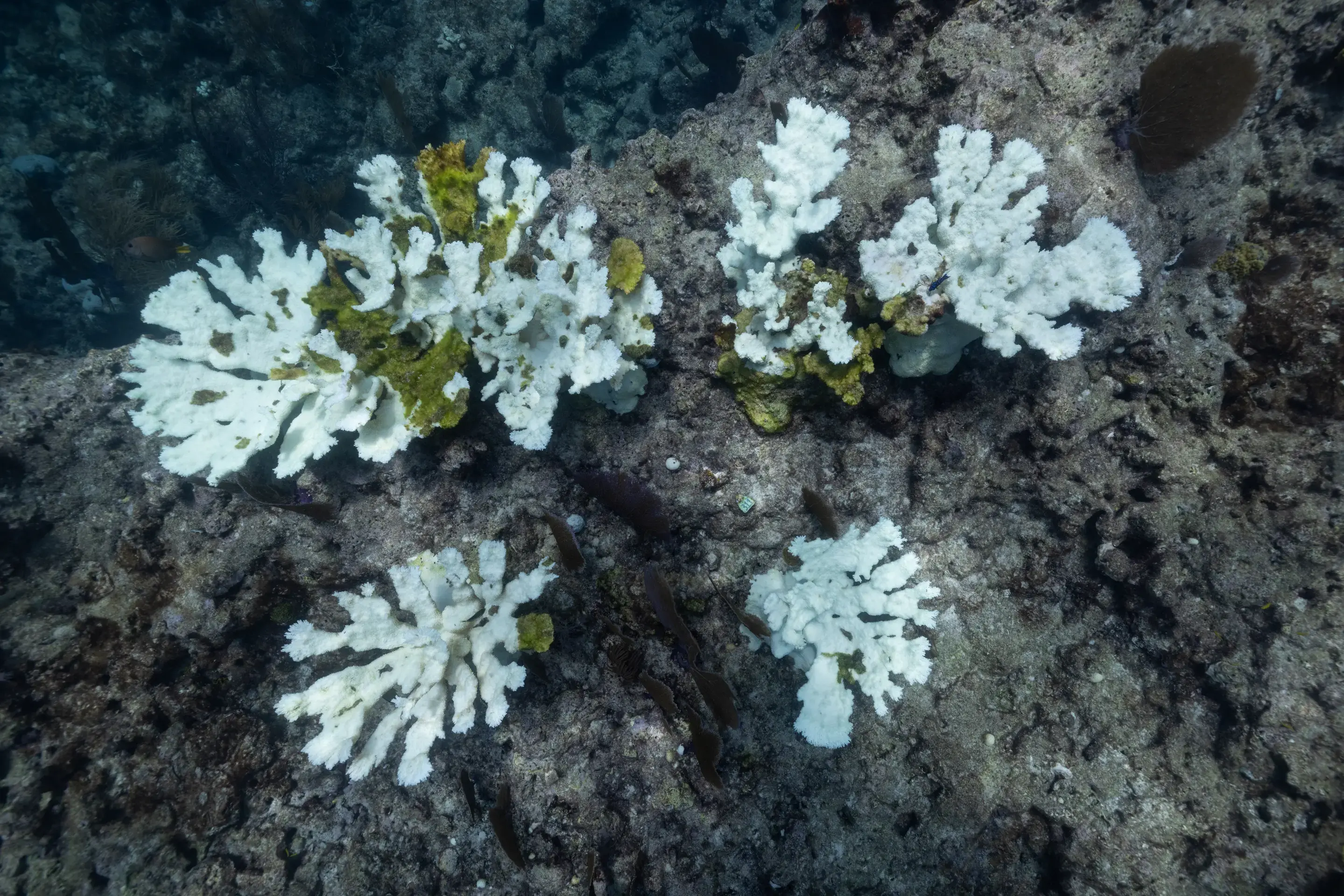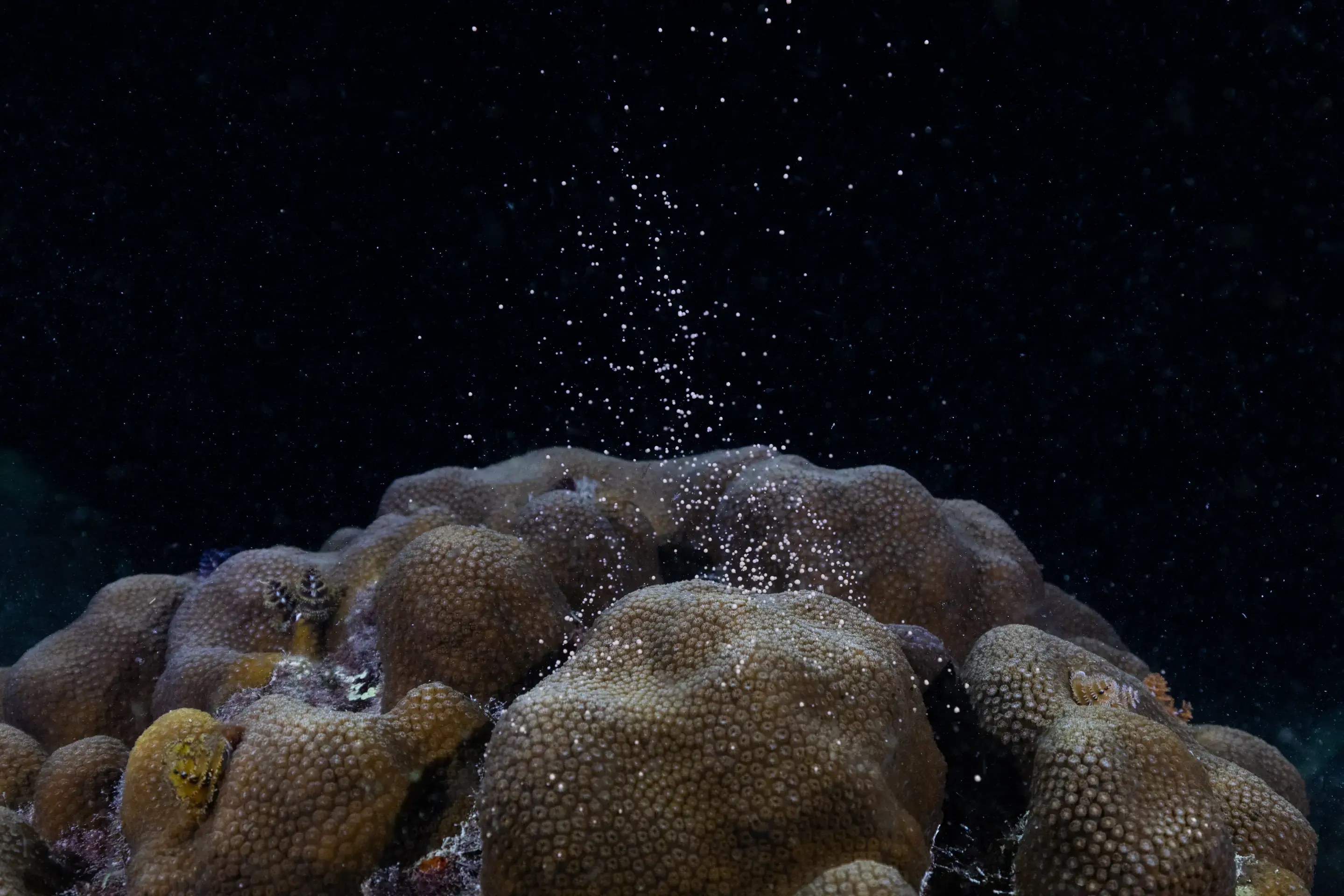
An extreme heat wave has pushed Florida’s reef to the brink — and burned up years worth of progress.
PICKLES REEF, FLORIDA — As soon as our boat reached the reef, the problem appeared. Looking down through the clear, turquoise water, I saw a handful of stark white patches on the seafloor, some 20 feet below.
I strapped on a tank, leapt into the ocean, and sank down near one of them. It was a large cluster of elkhorn coral, a threatened species that looks a bit like studded moose antlers sprouting from the reef. Normally, elkhorn is a vibrant, golden brown. Here it was bone white, a sunken skeleton.

As a nonprofit journalism organization, we depend on your support to fund more than 170 reporting projects every year on critical global and local issues. Donate any amount today to become a Pulitzer Center Champion and receive exclusive benefits!


As I cruised along Pickles Reef, which isn’t far from Key Largo, more species of corals came into view. Some looked like tree branches; others resembled spindly fingers that moved with the current. All of them were white. It was as if the reef had been dusted with a fresh coat of snow — beautiful, but haunting.
In the world of coral biology, white is a bad color. It indicates that the corals, which comprise a colony of marine animals called polyps, have lost a kind of algae that lives within their bodies. Those algae give the corals most of their food and their brilliant color in exchange for nutrients and a place to absorb sunlight. White, or “bleached,” corals aren’t dead; they are starving to death.
The bleached corals I saw that afternoon at Pickles are a small part of a massive, ongoing tragedy: Across the Florida Keys and throughout much of the Caribbean, coral reefs have bleached and many of them are dying. Some of these starving corals are literally centuries old. Others were planted recently to revive the reefs, and their bleaching represents a devastating setback for coral restoration.
The culprit is extreme heat.
In the last three months, a marine heat wave has been cooking the Caribbean, breaking down the relationship between coral and those symbiotic algae. Some shallow buoys in South Florida registered temperatures in excess of 100 degrees in July — about as warm as a hot tub. And for weeks on end, reefs in the Florida Keys, the largest coral reef in the continental US, were soaking in 90-plus degree water. That’s well beyond the threshold for bleaching in this region.
/cdn.vox-cdn.com/uploads/chorus_asset/file/24925539/ezgif_1_8e10698c50.gif)
“I’ve never seen anything like this in this area, period,” said Ian Enochs, a coral biologist at the National Oceanic and Atmospheric Administration, who’s been monitoring Florida’s reefs for more than a decade.
This mass bleaching event has made an already bad situation worse. Well before summer, the area of healthy reefs in the Florida Keys had already declined by 90 percent, due to past heat waves, diseases, ocean acidification, and other threats. The majority of Florida’s reefs that remain, meanwhile, are eroding.
And the consequences of these declines are severe. Coral reefs function like seawalls, helping limit life-threatening storm surge during hurricanes; they’re the engine of the region’s tourism economy; and they provide a home to as much as a quarter of all marine life including fish that people eat.
The long-term outlook for coral reefs brings more bad news. As our cars and factories continue to blanket the Earth with carbon dioxide, heat waves will become more common and intense. Top climate scientists have warned that warming could wipe out 70 to 90 percent of the tropical coral reefs worldwide. This is not just a problem in Florida. It’s a problem everywhere.
This raises a difficult question: Does Florida’s reef — and coral reefs in similar dire situations around the world — have a future on our planet?
That afternoon in September wasn’t the first time I visited Pickles. I dived here in April of 2022 for a very different kind of story — one of hope.
At the time, underwater photojournalist Jenny Adler and I were documenting local efforts to restore Florida’s ailing coral reefs. Restoration is akin to tree planting: Groups like the Coral Restoration Foundation grow fragments of coral on structures in the open ocean, which they then “plant” on degraded reefs with an underwater adhesive. The effect is similar to planting saplings in a degraded forest — it gives the reef new life.
Diving in Pickles that spring, we saw large colonies of staghorn and elkhorn corals that CRF had planted a few years earlier. These older corals, which are both threatened species, had grown from small fragments into colorful, meter-wide structures. They were healthy and helped form a reef, shown below, like those that appear in postcards.


Coral restoration was working, I thought. People were hopeful. Florida’s reefs were starting to grow back. It was a rare conservation victory.
Then came July.
Here’s how the same location looks today. (The green tint on the corals below is algae that grows on colonies when they die. This is different from the good algae within healthy coral tissue).


“It’s heartbreaking,” said Roxane Boonstra, the dive training administrator at CRF who took us diving at Pickles earlier this month. “I’ve been working in the coral field for what feels like my whole life and I’ve never seen bleaching on this scale.”
In the last decade, CRF has planted more than 43,000 pieces of coral on Pickles. Since July, many of them have bleached or died, including nearly all the coral we saw.


While Florida’s coral reefs have bleached several times before, this event is nonetheless historic. “We’re looking at a heat stress event that is in excess of two times greater than anything that’s ever been experienced in Florida on record,” Derek Manzello, a coral reef ecologist at NOAA, told me in August. Temperatures in South Florida were not only the warmest on record, but the heat started earlier and lasted longer than it did during past bleaching events, Manzello said.
And it’s not only coral colonies in Florida that are suffering. Several other countries in the Caribbean and Latin America have also reported bleaching this summer including Mexico, Belize, and Puerto Rico. Many local communities in these regions are highly dependent on coral reefs for food or for work. “We’re talking about thousands upon thousands of miles of coral reefs undergoing severe bleaching heat stress,” Manzello told reporters in mid-August.

Some reefs in the Keys are much worse off than others, especially those that are shallow. On a warm weekday morning, we boated out to a reef off the coast of Key West called Eastern Dry Rocks. It’s one of seven sites that are part of Mission: Iconic Reefs, a multimillion-dollar effort involving NOAA, CRF, and other groups to resurrect reefs in this region.
After a smooth 20-minute ride, we suited up and dropped down to the bottom, 15 feet below. Bailey Thomasson, who leads restoration here for CRF, toured us around, showing us coral after coral that her team had planted. Some were small, about the size of a hand; others stretched a couple of feet above the reef.
They were nearly all dead and coated in algae or bone white and bleached. It was as if a white plague had spread across the reef.

I did see a handful of neon green and blue corals, which popped against the monochrome reef. This was a good sign, I thought. But back on the boat, Thomasson explained that they, too, were bleached. Some corals produce bright pigments that function as sunscreen to protect themselves (and possibly to also attract those important algae partners that they lost). What I saw wasn’t a healthy color — it was a sign of dire stress.
Seeing all this bleaching is not only gut-wrenching, but it also points to an obvious challenge with restoration: Organizations are putting corals into an ocean that’s killing them.
This challenge is not lost on researchers.
“Restoration as we currently do it is not working in Florida,” Enochs of NOAA told me. “The fact that we are putting out corals that are ultimately just going to die is, in my opinion, irresponsible.”
This doesn’t make restoration pointless, several scientists told me. It just underscores the need to do it a bit differently.
Our dives weren’t all bleak. A large patch of staghorn coral at Pickles looked healthy. It was an orangey beige and its tentacles were poking out (coral polyps are a bit like sea anemones with stinging tentacles around a mouth). Elkhorn corals in CRF’s coral nursery, where the group raises corals to plant, were colorful and healthy, too, resembling pieces of fried chicken dangling from PVC and fiberglass structures.


This is key: Some coral colonies tolerate heat better than others.
Why? Research has shown that thermal tolerance among corals is, to an extent, genetically based, and resistance to other threats like disease may be rooted in their DNA, as well. And it’s this fact that underlies the future of coral restoration. Scientists essentially want to plant corals on the reef with underlying genetics that give them a leg up.
One way they do this is by helping corals breed and produce coral babies. It’s a numbers game: The more genetically distinct babies you have, the more likely it will be that some of them are tolerant to extreme heat, disease, or other threats.
This approach is important in a place like Florida, where the reef is so damaged that corals have trouble breeding on their own. Corals breed by spawning: Once a year, a set number of days after a full moon, colonies puff out bundles of sperm and eggs (or just sperm or eggs, or in some cases, larvae). In order for the eggs of one individual to be fertilized, they have to encounter the sperm of another. But there are so few healthy corals in Florida that their spawn often don’t meet.

That’s where self-described “coral baby doctor” Hanna Koch comes in. A scientist at the Mote Marine Laboratory and Aquarium, Koch, who’s both serious and prone to laughter, coaxes coral parents into spawning in giant tanks on land. She and Celia Leto, a staff biologist, use that spawn to produce genetically diverse coral babies — nearly invisible to the naked eye — which Mote will eventually plant on local reefs.
The idea here is that some of those babies will survive extreme heat or other stresses and give rise to the next generation. “We are restoring our reef with corals that have the best possible chances of surviving and coping with continued environmental stress,” Koch told me.
This approach produces a diverse crop of babies with varied traits. But scientists can also breed corals for a single trait, such as heat tolerance, in the same way that a farmer might breed fruits to make them sweeter. This method is known as selective breeding.
Breeding two corals that can survive extreme heat tends to produce babies that also have built-in heat tolerance. What’s more, scientists can breed algae symbionts — the organisms that live inside healthy corals — to be more heat tolerant, as well. “It’s like bartending,” Kate Quigley, a coral ecologist, said of selective breeding corals. “You’re just mixing things in different proportions.”
A researcher at Australia’s Minderoo Foundation, Quigley has shown that it’s possible to selectively breed some corals and their algae to withstand slightly higher temperatures over a few weeks, potentially increasing the survival of corals by 26-fold when oceans warm up. Other research has shown that even if just one parent has a higher heat tolerance it will produce more thermally tolerant babies.

Selective breeding may sound great, but it has some major limitations. For one, the process is slow and hard to scale up; corals take years to grow and reach a size where they can spawn. Plus, you can only tweak a coral’s traits by so much. “There is a hard ceiling to the biology,” Quigley said. Researchers may be able to stretch the coral’s heat tolerance by a few degrees, but it almost certainly won’t be enough for them to cope with future heat waves.
That brings us to the biggest problem of all: Even the most advanced restoration efforts are only temporary solutions. They’re just buying time. The only true solution, roughly a dozen experts told me, is for countries and companies to quickly ramp down their carbon emissions. Even then, aggressive restoration will still be needed to help reefs hold on.
“People will criticize restoration, asking why we are throwing millions of dollars at this effort that’s going to fail,” Boonstra of CRF said. “Well, it’s only going to fail if you think that this is all that’s needed. All we’re trying to do is keep things alive until other people take the big hard steps that are necessary.”
By the time Jenny and I arrived in Florida, the water had cooled down from the summer peaks by several degrees. It was in the mid-80s — near the upper limit of what corals can tolerate. Yet it’s still hot. And even if the water does cool down, as it should as the year progresses, recovering corals can still be prone to disease and struggle to reproduce.
So where does that leave the Florida Keys? Is it doomed?
It will be months before researchers do a full assessment of this summer’s bleaching. Some deeper reefs, and those farther north, are better off and may have avoided bleaching, scientists say. But in the short term, it’s not looking great.
Over the long term, as heat waves intensify, it’s unlikely that coral will disappear altogether. Some species are hardier, such as a type of soft coral called sea fans; they’re important to wildlife but don’t build reefs in the same way as hard corals. Ultimately, it’s just a question of what future reefs will look like — degraded, and providing little value to humans and marine animals, or full of life and beauty, as they once were.
“I think it’s likely that reefs are going to persist in the future,” said Liam Lachs, a doctoral researcher at Newcastle University who has studied heat tolerance in corals. “The question is, what’s the composition of the reefs? Do they still provide the services that they had historically provided?”
How we reported this story
Vox reporter Benji Jones and underwater photojournalist Jennifer Adler traveled to the Florida Keys in early September and dived reefs in the Upper and Lower Keys, spending a total of 6.5 hours underwater. Two of their dives were at night to see coral spawning (which is how corals sexually reproduce). Jones spoke to more than a dozen coral experts and restoration practitioners for this story and Adler took more than 5,000 photos. Special thanks to Margaret Miller, research director at Secore International, a coral restoration group.
For now, even in its bleached and dying state, parts of the reef are still holding on.
Around 9:30 pm on a clear night, Jenny and I were gearing up to dive on Looe Key, another spot with substantial bleaching. This was a critical moment: We were here to see if any wild corals on the reef would spawn, perhaps leading to a new generation of corals with new genetic diversity.
It felt like a long shot. Corals only spawn once a year for a few minutes, typically in the middle of the night, and they’re unlikely to reproduce if they’re bleached or otherwise stressed out. To see spawning here would be “miraculous,” said Koch, who was with us that night, “given the scope and scale of degradation and devastation.”
At night underwater, sea critters that are typically hiding during the day come out. A 4-foot stingray cruised the seafloor under the beam of my flashlight. Lobster antennae poked out of dark crevices. A small moray eel, its mouth wide open, waited for a hapless fish to swim by. Dozens of henchmen-like barracudas lurked above me.

Hovering in pairs next to healthy corals, we waited, our bodies rising and falling with every breath. When our air ran low, we popped up to the surface, switched out our tanks, and swam back down.
Now it was around 10:30 and we were on our third dive of the night. The water around us sparkled with bioluminescent critters. Then I saw a light flashing frantically a few meters away. I swam over to find Koch and Leto staring closely at a large mound of a knobby brown coral. They pointed ecstatically.
With all of us in a circle around the coral, the show began. Section by section, the colony — a species known as lobe star coral — began to expel little pink balls, like an upside down salt shaker. They hovered above the coral for a second before getting swept away by the current.

In each of those balls were several eggs and millions of sperm. If all goes well, they’ll drift around the ocean until they cross paths with the sperm and eggs of another coral that also spawned that night. Together, they’ll produce coral larvae that will swim to the ocean floor and start a colony of their own, creating the next generation of coral in the Florida Keys — assuming it’s not too hot for them to thrive.
Jennifer Adler contributed reporting.











